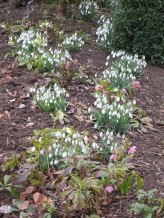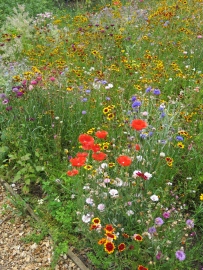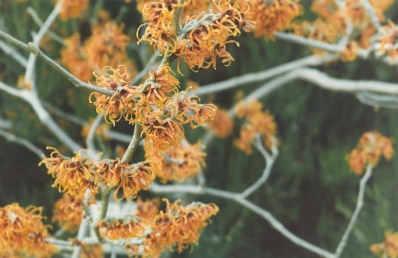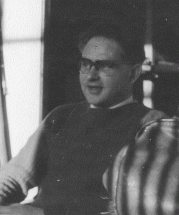● Plant Conservation ● Key Events ● New Winter Garden ● Flora Europaea Conference ● National Council for the Conservation of Plants and Gardens (NCCPG) ● Key People ●
 The new Winter Garden, now considered as ‘one of our country’s most celebrated winter gardens’ was developed by Peter Orriss and Norman Villis between 1978 – 1979.
The new Winter Garden, now considered as ‘one of our country’s most celebrated winter gardens’ was developed by Peter Orriss and Norman Villis between 1978 – 1979.
John Gilmour Director of the Cambridge University Botanic Garden (1951 – 1973) retired after more than two decades in 1973. Together with his Garden Superintendent Bob Younger, (1947 – 1974) John Gilmour had led the transformation of the eastern section of the ‘New Area’ from vegetable allotments to innovative new ecological planting such as the Sensory Garden, the Limestone Rock Garden, the Chronological Bed and the Ecological Wildflower Mound. New Director Dr Max Walters (1973 – 1983) and Garden Superintendent Peter Orriss (1975 – 1987) and Supervisor Norman Villis (1974 – 1995) would go on to lead the development of further areas, including the celebrated ‘new’ Winter Garden in 1978-79. Conservation issues both nationally and internationally gathered momentum through conferences such as the launch of the Flora Europaea in 1977 and the establishment of the NCCPG in 1978.
Key Events in the 1970s
1970 Edward Heath (Conservative) Prime Minister 1970 – 1974
1970 First Earth Day, 22nd April 1970
1971 Friends of the Earth UK established
1972 Charles Roy Lancaster awarded Veitch Memorial Medal by RHS
1973 Director John Gilmour retires after 22 years
1973 Dr Stuart Max Walters takes on the role of Director of the Botanic Garden
1974 Bob Younger retires after 27 years as Superintendent
1975 Peter Orriss promoted to Superintendent
1974 Harold Wilson (Labour) Prime Minister 1974 – 1976
1976 James Callaghan (Labour) Prime Minister 1976 – 1979
1977 International Conference for Flora Europaea, Kings College, Cambridge
1977 Silver Jubilee of Queen Elizabeth II
1977 British Red Data Book of Endangered Species
1977 Endangered species propagation with Royal Botanic Garden, Kew
1977 The Chronological Bed moved to its current location
1977 Conservation Section sponsored by ICI
1977 Computer-generated key
1978 New Winter Garden developed
1978 Nat. Council for the Conservation of Plants and Gardens (NCCPG) established
1978 Teacher’s Guide to the Botanic Garden developed
1979 Margaret Thatcher (Conservative) Prime Minister 1979 – 1990
1979 James Lovelock publishes Gaia: A New Look at Life on Earth.
New Winter Garden In 1978, Peter Orriss (below centre), Superintendent and Norman Villis (below right), Garden Supervisor (pictured with Donald Pigott below left), began work on the development of a new and highly influential Winter Garden. The first Winter Garden planted by Bob Younger in 1953-54 was now in a private research area of the Garden; the challenge was to create a new landscape design with plants which are at their best during the winter and spring months – from December to April.
 Careful thought went into sculpturing and re-shaping an area into a shallow valley to allow in the low-level winter sunlight and to add welcome colour and fragrance during the darkest months of the year. Brightly coloured stems, barks and leaves add splashes of brilliance into the planting. Acer barks, pollarded Salix (willow) stems, Prunus davidiana alba and Bergenia leaves. Delicate aconites, Jasminum nudiflorum Winter-flowering Jasmine, Viburnum x bodnantense Deben with white flower emerging from pink buds, Lonicera x purpusii Winter Beauty and Mahonia japonica with its lily of the valley scented flowers
Careful thought went into sculpturing and re-shaping an area into a shallow valley to allow in the low-level winter sunlight and to add welcome colour and fragrance during the darkest months of the year. Brightly coloured stems, barks and leaves add splashes of brilliance into the planting. Acer barks, pollarded Salix (willow) stems, Prunus davidiana alba and Bergenia leaves. Delicate aconites, Jasminum nudiflorum Winter-flowering Jasmine, Viburnum x bodnantense Deben with white flower emerging from pink buds, Lonicera x purpusii Winter Beauty and Mahonia japonica with its lily of the valley scented flowers
 Since the 1970s, Orris and Villis’ imaginative and colourful seasonal plantings have inspired the creation of other Winter Gardens around the country, including at Anglesey Abbey, Cambridgeshire, planted in 1998. The Botanic Garden Winter Garden has featured in numerous television and radio programmes as well as appearing in colour magazines. BBC Gardeners’ World presenter, Rachel de Thame, visited the garden in March 2013 to discuss the ‘celebrated winter gardens’ with Dr Tim Upson, Curator and Acting Director.
Since the 1970s, Orris and Villis’ imaginative and colourful seasonal plantings have inspired the creation of other Winter Gardens around the country, including at Anglesey Abbey, Cambridgeshire, planted in 1998. The Botanic Garden Winter Garden has featured in numerous television and radio programmes as well as appearing in colour magazines. BBC Gardeners’ World presenter, Rachel de Thame, visited the garden in March 2013 to discuss the ‘celebrated winter gardens’ with Dr Tim Upson, Curator and Acting Director.
Flora Europaea Conference Flora Europaea has been described as ‘one of the most important taxonomic works published in [the 20th century].’ The idea for the Flora was first mooted at the International Botanical Congress held in Paris in 1954. The final conference, held at King’s College, Cambridge in 1977, brought together 131 delegates from 30 countries. Peter Sell recalls: “It was probably the last time that a great group of Cambridge botanical taxonomists who originated as Gilbert-Carter students in the 1930s, which included the editors of Flora Europaea, and those who were Max [Walters]’s students between 1950 and 1970 came together in one place.”
 National Council for the Conservation of Plants and Gardens (NCCPG) was established as a charity in 1978 by a group of botanists, horticulturalists, conservationists and gardeners. Max Walters was one of the founding members. The aim of the organization – which changed its name to Plant Heritage in 2009 – is to encourage the propagation and conservation of cultivated plants in the British Isles. It was to be another few years before a horticultural taxonomist was appointed and the task of the criteria for National Plant Collections approved. Read more 1980s Biodiversity.
National Council for the Conservation of Plants and Gardens (NCCPG) was established as a charity in 1978 by a group of botanists, horticulturalists, conservationists and gardeners. Max Walters was one of the founding members. The aim of the organization – which changed its name to Plant Heritage in 2009 – is to encourage the propagation and conservation of cultivated plants in the British Isles. It was to be another few years before a horticultural taxonomist was appointed and the task of the criteria for National Plant Collections approved. Read more 1980s Biodiversity.
 Key People
Key People
John Gilmour (1951 – 1973) retired as Director of the Botanic Garden in 1973. He and his family – wife Molly and their three daughters – had lived in Cory Lodge, in the heart of the Garden with a menagerie of pets. Bob Younger (Garden Supervisor 1947 – 1974) retired a year after his long-term colleague, John Gilmour. Together, John Gilmour and Bob Younger’s partnership had transformed the 13-acres of the eastern section of the Garden and inspired a new generation of gardeners and horticulturalists.

Max Walters (1973 – 1983) In 1973, Max Walters took over the Directorship of the Garden, after John Gilmour retired. Max Walters knew the Cambridge University Botanic Garden well, having studied there during his undergraduate and postgraduate degrees. Max had also worked as Curator of the Herbarium in the School of Botany since 1950. John Gilmour and Max Walters had both been involved in the Herculean task of writing of the Flora Europaea, a taxonomic flora of Europe, co-ordinating with colleagues across Europe. The project was finally concluded with an International conference held at King’s College Cambridge in 1977.
Peter Orriss became Garden Superintendent in 1974 after Bob Younger retired. Peter had trained at Cambridge University Botanic Garden in 1944 as a young boy, and had returned to the Botanic Garden after National Service in 1950. Under the Directorship of Max Walters (1973 – 1983) and Donald Pigott (1984 – 1995), Peter created a range of creative new plantings, including the New Winter Garden with Norman Villis in 1978.
Voices from the 1970s Listen to Norman Villis talking about ideas behind the creation of the New Winter Garden. Garden from the Air.
Follow the Story of the Botanic Garden as it has grown, expanded and changed since WWII: A Garden through time, 1950s Brave New Garden, 1960s Ecology by Design, 1980s Biodiversity,1990s Sustainability for Survival, 2000s Engaging with Plant Sciences, The Future is Now.



